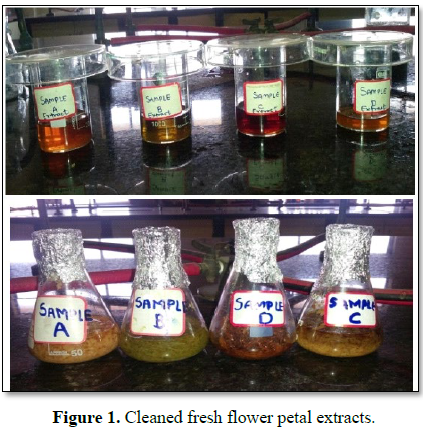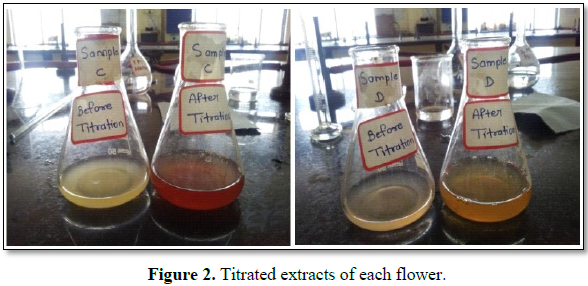1084
Views & Citations84
Likes & Shares
Today synthetic indicators are used to show sharp
color change at intervals of pH in acid base type of titrations. Many more
synthetic indicators are used in acid base titration, but they are slightly
expensive and are unavailable, so attempt has been made to establish the
indicator activity of flower pigments to replace synthetic indicators as they
have certain disadvantage like their chemical synthesis, chemical hazards, high
cost, availability problems and environmental pollution. The present work
highlights the use of the hydro alcoholic extract of the flowers of few common
plants as an acid-base indicator in acid-base titrations. This natural
indicator is easily available as well as easy to extract and gives sharp
intense color change at the equivalence point as compared to phenolphthalein
and methyl orange. As these flower extracts have simple, cost-effective,
environment friendly extraction procedure and excellent performance with sharp and
intense color change in end points during the acid base titrations, it would be
possible to replace the synthetic indicators being used in conventional
laboratories with natural flower indicators.
Keywords: pH
indicators, Flower pigments, Neutralization indicators, Phenolphthalein
substitutes, Titrations
INTRODUCTION
Jasminum officinale,
also called as the common jasmine, is a species of flowering plant belonging to
the family Oleaceae can grow up to height 15-30 ft. It is a vigorous, twining,
bright, deciduous climber with sharply pointed pinnate leaves and produces the
large flush of clusters of starry, pure white colour flowers in summer season,
which are the source of its heady scent [1,2]. The oil extracted from Jasminum officinale is used in
aromatherapy. Jasmine absolute is also known as the ‘King of Oils’ and its
heavy, having sweet scent is loved by most people. The flowers release their
perfume at dusk, so that the flowers are picked at night and a tiny amount of
oil is removed by using solvent extraction method [3,4]. It is very expensive
oil therefore used in low concentrations. As an herbal medicine, it is used in
the treatment of dermatology as either an antiseptic or anti-inflammatory agent
[5]. It is cultivated in the northern Iran, Afghanistan, Pakistan, Himalayas,
India, Nepal and western China. The species is also cultivated in many places
like in Spain, France, Italy, Portugal, Romania and West Indies [6]. It is the
National flower of Pakistan.
Ixora
coccinea also called as jungle geranium, is a species belonging to the family
Rubiaceae. It is a dense, multi-branched evergreen shrub, commonly grows up to
4-6 ft (1.2-1.8 m) in height. The glossy and leathery leaves are about 4 in (10
cm) long, with entire margins and are carried in opposite pairs or whorled on
the stems. Small tubular shape, flowers in dense rounded clusters 2-5 in (5.1-12.7
cm) and are found in a wide range of colors across are produced throughout the
year. The flowers, leaves, roots, and the stem are used to treat various
diseases in the Indian traditional system of medicine [7]. The fruits, when get
fully ripe, are used as a dietary supplement. There are about 400 species
spread from Africa to Southern Asia. They differ in their leaf size, plant
height, flower size and flower color, etc. It is a common flowering shrub well
cultivated in Southern India [8,9].
MATERIALS AND METHODS
Plant materials
Fresh
flowers of Jasminum officinale
(sample C) and Ixora coccinea (sample
D) was collected from campus of Ideal College of Pharmacy & Research, India
in the month of March.
Reagents and glassware’s
The
study was well performed by using analytical grade reagents as per standard
were made available from ideal college of pharmacy and the whole experimental
work was performed by using the clean and same set of glassware’s. The reagents
and volumetric solutions were prepared as per Indian pharmacopeia.
Preparation of flower
extract
Cleaned
fresh flower petals of each plant, first crushed in mortar then transferred
into conical flask and added enough 90% ethanol to produce 50% concentration of
extract, followed by maceration method of extraction for 48 h. Each extract was
then preserved in well closed container and stored away from direct sun light (Figure
1).
Methods
The experiment was performed by using the same set of glass wares for
titration of each flower extract. Titrant of 10 ml with 2 to 3 drops of
standard indicator (Phenolphthalein) was titrated against 1 molar acid-base.
The results were depicted in the experiment was carried by using the same set
of glass wares for titrations of each flower extracts.
The equimolar (1 M) titrations were performed using 10 ml of titrant with
2 ml of indicator (aqueous). All the parameters for each experiment are given
in table format. A set of three experiments, each for acid base titrations were
carried out. The mean calculations for each titration were calculated from
results obtained (Figure 2).
RESULTS AND
DISCUSSION
The study proved that the equivalence point of acid-base titrations using
the all different flower extract either coincided or almost closer to that of
using standard phenolphthalein indicator. The each of flower extract indicator
gave sharp color change at the equivalence point during titration. It was also
observed that the all extract acted reversibly and gave sharp color change in
both directions (Tables 1-4).
Conclusion
The study revealed that the hydro alcoholic extract of each flowers of Jasminum officinale and Ixora coccinea can be used as a
substitute to the synthetic indicators due to its advantages like easy
preparation, effective performance and ability to produce accuracy and
precision in results as per followed by green chemistry [10-13].
ACKNOWLEDGEMENT
The authors wish to express their sincere thanks and appreciation to the
Ideal College of Pharmacy and Research Institute. The success and outcome of
this project required a lot of guidance and assistance from many people and I
am extremely privileged to have got this all along the completion of my
project. All that I have done is only due to such supervision and assistance
and I would not forget to thank them. The cooperation extended by my professors
for providing data and information about herbal indicator synthesis for green
chemistry is highly acknowledged.
1. Chakraborty
DD, Paul C, Ghosh A, Chakraborty P (2014) Natural indicator as a substitute to
synthetic indicator - A developmental approach. J App Pharm Sci 4: 120-212.
2. Watson DG (1999) Pharmaceutical analysis: A
textbook for pharmacy students and pharmaceutical chemists. Churchill
Livingstone. Harcourt Publishers Limited UK, pp: 51-52.
3. Bhagat VC, Patil RD, Channekar PR, Shetty SC,
Akarte AS (2008) Herbal indicators as a substituent to synthetic indicators.
Int J Green Pharm 2: 162-163.
4. Abbas
SK (2012) Study of acid-base indicator property of flowers of Ipomoea biloba Abbas. Int Curr Pharm J
1: 420-422.
5. Patil
SB, Kondawar M, Ghodke D, Naikwade NS, Magdum C (2009) Use of flower extracts
as an indicator in acid-base titrations research. J Pharm Technol 2: 421-422.
6. Obando
OD, Dambata BB, Ukpumwan DO (1995) Predicting light fastness of dyes on
textiles from spectra of their photo-fading in solutions - A preliminary
report. J Chem Soc Nig 20: 8-17.
7. Mendhan
J, Denney RC, Barnes JD, Thomas MJ (2002) Vogel’s textbook of quantitative
chemical analysis. Pearson Education Pvt. Ltd. 6th Edn, p: 313.
8. Dunnick
JK, Hailey JR (1996) Phenolphthalein exposure causes multiple carcinogenic
effects in experimental model systems. Cancer Res 56: 49224926.
9. RHS
(2008) A-Z encyclopedia of garden plants. United Kingdom: Dorling Kindersley,
p: 1136. ISBN 1405332964.
10. Rapini,
Ronald P, Jean L, Joseph L (2007) Dermatology: 2-volume set. St. Louis: Mosby,
p: 2049. ISBN 1-4160-2999-0.
11. BSBI
List (2007) Botanical Society of Britain and Ireland. Archived from the
original (xls) on 2015-01-25. Retrieved 2014-10-17.
12. Baliga
MS, Kurian PJ (2012) Ixora coccinea Linn: Traditional uses, phytochemistry and
pharmacology. Chin J Integr Med 18: 72-79.



